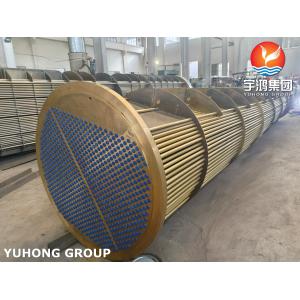

Add to Cart
Brass Copper Alloy Steel Tube Bundles for Shell / Tube Heat Exchanger Condenser
Tube bundles are commonly used in heat exchangers and other types of process equipment for efficient heat transfer between two fluids. A tube bundle consists of a series of tubes that are bundled together and held in place by tube sheets or baffles. The tubes can be arranged in various patterns, such as in-line, staggered, or triangular, depending on the desired heat transfer characteristics, with materials such as copper, steel, stainless steel, or titanium being commonly used.
In a heat exchanger, one fluid flows through the tubes (known as the tube-side fluid) while the other fluid flows over the exterior surface of the tubes (known as the shell-side fluid). Heat is transferred from the higher-temperature fluid to the lower-temperature fluid through the tube walls. The design and arrangement of the tube bundle play a crucial role in determining the heat transfer efficiency and pressure drop of the heat exchanger. Regular maintenance and cleaning of tube bundles are essential to prevent fouling and maintain optimal heat transfer efficiency. Techniques such as mechanical brushing, chemical cleaning, or water jetting may be employed to remove deposits or scale that can accumulate on the tube surfaces over time.
Tube Bundles
Common use material for Tube Bundle Heat Exchanger
There are two different of tube bundles: Straight tubes and U tubes. Depending on specific requirement and application, there are following tube material options:
Carbon Steel Tube : ASTM A179/ASME SA179/179M, ASTM A192, ASTM
A333, ASTM A334
Alloy Steel Tubes: ASTM A213 T5, T9, T11, T22, T91
Copper Tubes
Common Tube sheet material options
Carbon Steel: ASTM A516 Gr.70 , etc.
Stainless Steel:304, 304L, 316L , etc.
Alloy Steel: Alloy steels, such as ASTM A387 Gr.11 , Gr.22 , etc.
Duplex Stainless Steel: 2205 , S31803, etc.
Nickel Alloys: Nickel-based alloys, Inconel 600 or Hastelloy C276, etc.
Copper alloys used in tube bundles
Copper-nickel alloys, such as Cu-Ni 90/10 (90% copper and 10% nickel) and Cu-Ni 70/30 (70% copper and 30% nickel), are often used in tube bundles for their excellent corrosion resistance, thermal conductivity, and mechanical properties. Other copper alloys like brass (copper-zinc) or bronze (copper-tin) can also be utilized depending on the specific application.
Copper alloy tube bundles offer several advantages compared to other grades of tube bundles.
Excellent Heat Transfer: Copper is known for its high thermal conductivity, which allows for efficient heat transfer. This means that copper alloy tube bundles can effectively facilitate the transfer of heat from one fluid to another, resulting in enhanced overall performance and energy efficiency.
Corrosion Resistance: Copper alloys, such as brass or bronze, exhibit excellent corrosion resistance properties. They are highly resistant to oxidation, erosion, and galvanic corrosion, making them suitable for various applications involving aggressive media or environments. This corrosion resistance helps prolong the lifespan of the tube bundles and reduces maintenance requirements.
Compatibility with Different Fluids: Copper alloy tube bundles are compatible with a wide range of fluids, including water, steam, oils, gases, and many chemicals. This versatility makes them well-suited for use in diverse industrial processes across industries like HVAC, refrigeration, oil and gas, power generation, and chemical processing.
Formability and Ease of Installation: Copper alloys possess good formability, allowing for ease of manufacturing and installation. They can be readily bent, shaped, soldered, or brazed into complex configurations, facilitating customization to specific requirements. The ease of installation also contributes to reduced downtime during maintenance or replacement.
Antibacterial Properties: Copper and certain copper alloys have inherent antibacterial properties, commonly referred to as the "oligodynamic effect." These properties inhibit the growth of harmful microorganisms, including bacteria and fungi, on the surface of the tubes. As a result, copper alloy tube bundles are often used in applications where cleanliness and hygiene are critical, such as food processing, medical equipment, and potable water systems.
Recyclability: Copper alloys are highly recyclable, and their scrap value remains significant. Recycling copper tube bundles not only reduces waste but also contributes to resource conservation and sustainability efforts.
Applications
Copper alloy tube bundles find extensive use in various industries. They are commonly employed in heat exchangers, condensers, boilers, and other types of equipment where efficient heat transfer is essential. Additionally, they are utilized in desalination plants, power generation facilities, marine applications, and offshore oil and gas platforms.
